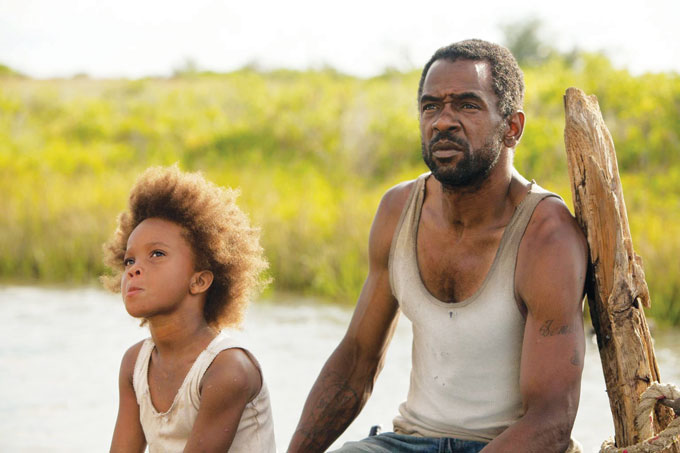Next story: On The Boards Theater Listings
Beasts of the Southern Wild
by George Sax

Endangered Childhoods
Beasts of the Southern Wild
What do you think the odds are that here and now, amid moviedom’s season of bombshell blockbusters, two much smaller-scaled films, each with its own singular vision, each about the trials and perils of childhood, would open in close succession? Pretty slim, I’d say. But it’s just happened, and people who profess an interest in things cinematic probably should make an effort to catch both of them, preferably in theaters.
I don’t mean that both will meet with the enthusiastic approval of such movie fans, just that they’re markedly unusual, and technically accomplished, cleverly realized, and yes, odd enough to merit a look.
Wes Anderson’s Moonrise Kingdom has been in distribution for some weeks now, and this week it will be joined locally by Benh Zeitlin’s Beasts of the Southern Wild. Beyond the striking singularity of their makers’ visions, these movies both have a central focus on children’s perspectives, Beasts more than Moonrise, and both are set in richly imagined, almost otherworldly ambiances.
Anderson’s film has provoked decidedly mixed reactions, as his work has increasingly done since his debut feature, Rushmore, 15 years ago. He’s regularly described by the skeptical as heavy-handedly whimsical, even preciously artificial. Moonrise is certainly complexly stylized, and sometimes determinedly artificial, particularly visually. Its spirit can try the patience of some reviewers and audiences. Entertainment Weekly’s Owen Gleiberman called Anderson’s latest movie “another bric-a-brac-jammed bauble,” and it’s not too hard to feel a twinge of sympathy for his exasperation. Anderson sometimes seems to be courting exasperation. Moonrise is about the puppyish romance of a pair of 12-year-olds, a boy and a girl, and their escape from adult authority to a vaguely Neverlandish New England island, and its appreciation requires a certain amount of acceptance of a lot of stylistic manipulation and a fair proportion of deadpan ridiculousness, particularly where the somewhat hapless, helpless adults are concerned. Obviously, some people aren’t going to go there with Anderson. (I’ll admit to some resistance to his devices.) Others—and I’m in this camp, too—are going to find the intricately engineered nonsense enjoyable, and at least modestly touching, finally.
Zeitlin’s Beasts is a strikingly different kind of film, but it too imposes some burden on those who want to experience it sympathetically, on some people more than others, of course. In its own way, Beasts is even more divergent from the important currents of American filmmaking than Moonrise. Zeitlin, also the co-writer, is the son of two ethnologists and a member of a New Orleans film collective. His movie—his first feature-length one—is, I think, primarily his, whatever collaborative energy went into its making. It’s based on co-author Lucy Alibar’s play Juicy and Delicious, although it’s hard to imagine what this work was like from the movie.
At its center is Hushpuppy (Quvenzhané Wallis), a six-year-old African-American girl living with her father (Dwight Henry), a volatile, sometimes sullen and troubled man. Wallis is a find. She was supposedly discovered from interviews with 3,000 kids, and she’s not just engaging, she’s often engrossing.
Hushpuppy and her father live in a somewhat fantasticated, sub-ramshackle and marginalized little riverside neighborhood outside New Orleans called the Bathtub. The father-daughter relationship is crucial to Beasts, and its depiction is both bracing and affecting. Henry is admirable. (Like the rest of the cast, including Wallis, he had no professional performance experience.)
But it’s Wallis and Hushpuppy’s show. And they run with it. Hushpuppy isn’t just a remarkably vibrant, uncommonly articulate kid, she’s something of a metaphysician and moralist. In her assertive but unspoiled fashion, she views her young world as her oyster. She contains multitudes. In the voiceovers she provides, she tells us that 1,000 years from now, scientists will know she was here. “I see that I’m a little piece of a big, big universe, and that makes things right,” she says. Meanwhile, she must deal with her father’s secretive darkness, her impoverished isolation (which she experiences as a sense of local community), and an impending Hurricane Katrina.
Beasts is, among other things, something of an ecological parable. Hushpuppy has visions of melting glaciers and great, gnarly prehistoric boars roaming the delta. (These dream-like sequences have caused some reviewers to mistake the film’s style for magic realism.) But all this coincides with a kind of gutty, exaggerated naturalism. The Bathtub is grittily but rather fancifully conceived, and that includes the few residents introduced to us. It’s rendered with a controlled vividness that is never quite real. And eventually, Beasts devolves in the direction of domestic melodrama and Zeitlin infuses his film with an inspiriting celebration of the determination and courage of the common people, with Hushpuppy at its head. Some will fall in line with these sentiments, but at least a few are likely to find their patience tried.
Beasts entirely lacks the carefully styled irony of Anderson’s movie, but it’s not without contrivance. And Moonrise is not without a note of sadness and muted hope. Both films are memorable, whether you accept or reject their visions.
Watch the trailer for Beasts of the Southern Wild
|
Issue Navigation> Issue Index > v11n29 (Week of Thursday, July 19) > Beasts of the Southern Wild This Week's Issue • Artvoice Daily • Artvoice TV • Events Calendar • Classifieds |









 Current Issue
Current Issue